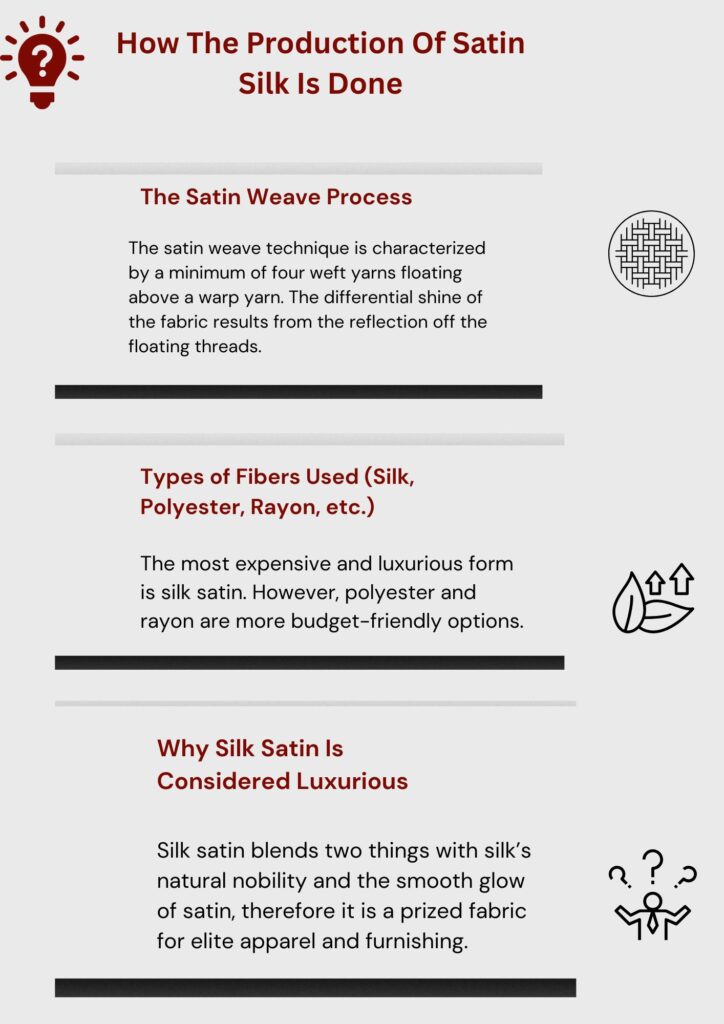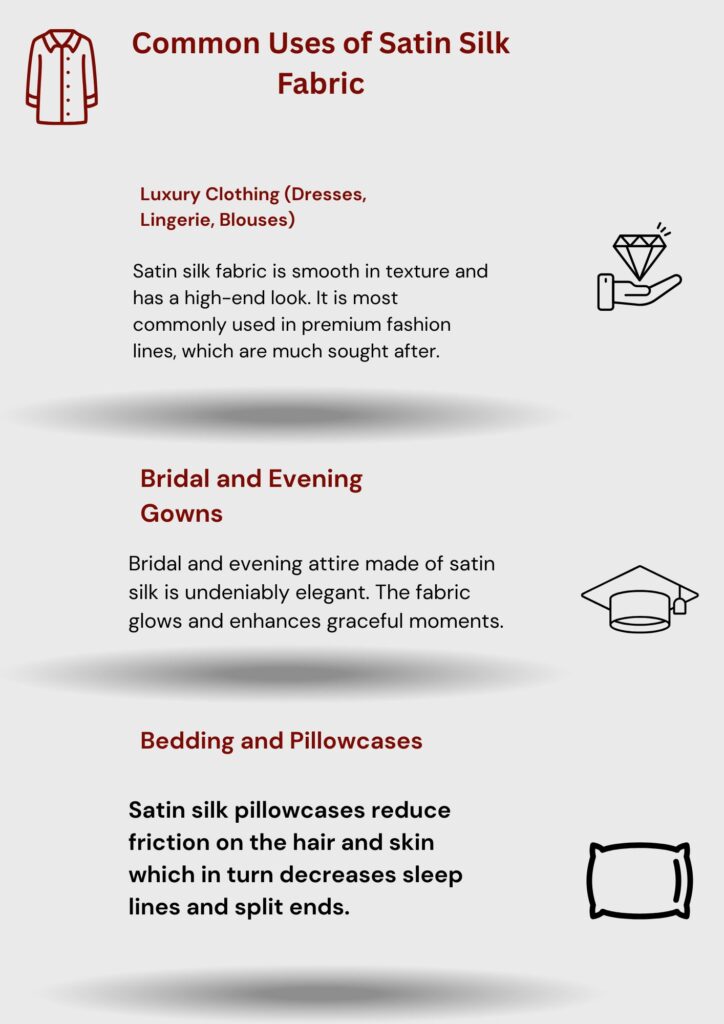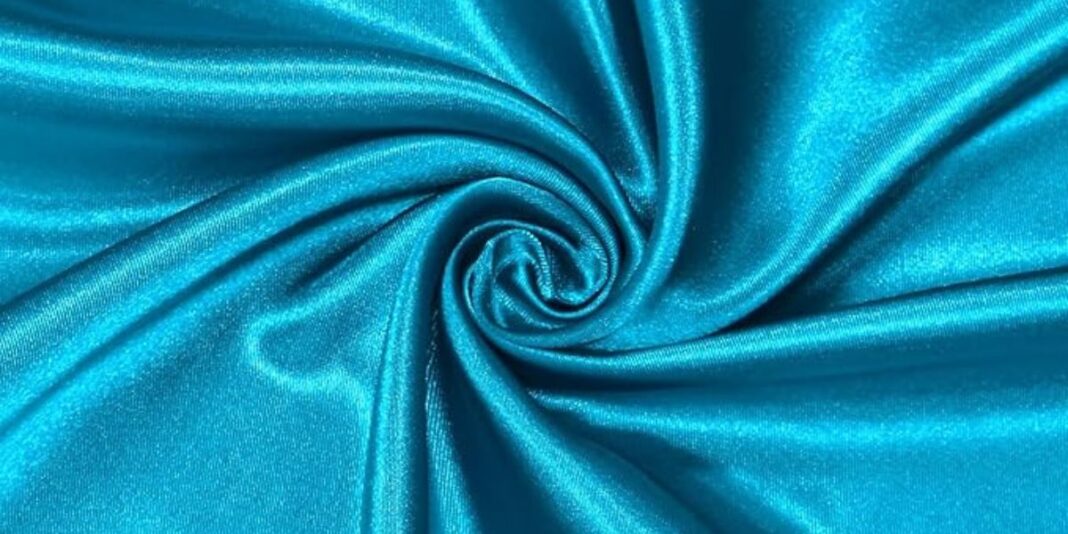Introduction
Brief Definition of Satin Silk
Blending natural silk fibers with the satin weave results in a fabric known as satin silk. It achieves a smooth and shiny surface which is soft to the touch. It also reflects light beautifully which gives it its signature glow, ultra-elegant appearance.What Is Satin Silk?
The method for creating the fabric’s satin weave consists of layering yarns which will give the fabric glossy and smooth edges as well as shine. The quality of silk satin is superb due to its luxurious nature and unmatched finesse. It is often used for high-end clothing, bedding, or other silk items.
Why It’s Popular in Fashion and Home Decor
Due to its comfort and beauty, satin silk is one of the most preferred fabrics. Women’s clothing such as wedding dresses, blouses, night gowns, and even luxury sheets incorporate this stylish fabric. For designers, it comes in handy due to its ease of use, exceptional drape, and lustrous sheen.
Satin silk is used in home décor to exude a feeling of comfort and warmth to one’s residence. Consider its use for exquisite drapes, plush pillowcases, or chic upholstery. Beyond looking undeniably stylish, satin silk feels delightful to the skin which is why many prefer it for their home.
Satin vs. Silk: Key Differences
Is Satin Silk Real Silk? (Clarifying Common Confusion)
This is a recurring area of confusion.:
Satin can also be constructed from polyester, nylon, or rayon, so not all satin fabrics are silk. “Satin silk” is often used to label satin fabrics which merely denote silk fibers woven using the satin method, resulting in a supremely graded fabric.
Comparison of satin (Weave) vs. Silk (Fiber)
Silk is a breathable, hypoallergenic protein fiber and is naturally soft and shiny which is aesthetically pleasing. A technique used in textile production that turns yarn into fabric where the front section is glossy, and the back is dull is referred to as satin.
Satin as a weave can be made of multiple fibers as polyester, silk, and acetate. Silk satin is different because it combines both the satin weave and pure silk fibers, which makes it more luxurious and expensive.
Pros and Cons of Each
Satin Pros:
- Cost-effective (particularly synthetic)
- Shiny and sleek
- Easily obtainable
Satin Cons:
- If synthetic, less breathable
- Snags easily
Silk Pros:
- Natural and breathable as well as hypoallergenic
- Lightweight yet strong
- Great for skin and hair.
Silk Cons:
- High cost
- Needs gentle cleanliness
How The Production Of Satin Silk Is Done

The Satin Weave Process
The satin weave technique is characterized by a minimum of four weft yarns floating above a warp yarn. The differential shine of the fabric results from the reflection off the floating threads. That glowing exquisite surface known as satin comes from the floating threads reflecting light.
The fabrics are smooth and tight in structure, which results in beautiful draping. When silk threads are used, this effect is even more pronounced, resulting in a soft and elegant finish.
Types of Fibers Used (Silk, Polyester, Rayon, etc.)
The most expensive and luxurious form is silk satin. However, polyester and rayon are more budget-friendly options. Though these synthetic counterparts replicate the look of silk satin, they do not possess silk satin’s natural softness, comfort, and ability to breathe.
Other common fibers used in satin fabrics include acetate and nylon. Fibers are important as they impact the texture, weight, and strength of the resulting fabric.
Why Silk Satin Is Considered Luxurious
Silk satin blends two things with silk’s natural nobility and the smooth glow of satin, therefore it is a prized fabric for elite apparel and furnishing.
It has unparalleled smoothness, rich draping, and comfort against the skin. In addition, it is sustainably produced and biogradable which appeals to eco-conscious consumers.
Types of Satin Silk Fabric
Charmeuse Satin
With a satin weave structure, charmeuse satin is light and drapes nicely. Generally, it has a shiny face and a back that is less shiny and dull.
Charmeuse satin is ideal for blouses, dresses, and even lingerie. It is sexy, elegant, and gentle to wear.
Duchess Satin
Duchess satin provides a heavier and stiffer fabric. It is perfect for crafted garments like formal gowns and wedding gowns.
This type of satin is richly lustrous and offers a dramatic look. It is also great for structured designs as it keeps shape well and has volumetric form.
Antique Satin
Antique satin is known for trying to replicate the texture of older historical fabrics.
often includes slubs or some threads woven in, which intensifies the vintage look.
Because of its charming vintage appeal, antique satins are primarily used in draperies and period-style costumes.
Stretch Satin
Stretch satin is characterized by satin that contains spandex or elastane and therefore has some stretch.
This type of fabric is common with close-fitting dresses and other fitted pieces of clothing. In spite of its stretch, it still possesses the glossy finish of satin silk.
Synthetic satin is made from silk that is man made. Like all synthetic fabrics, it is less breathable, and does not feel luxurious on the skin.
Lacking breathability and often feeling plastic-like, synthetic satin has some similarities to satin, but a more of a “Slippery” texture. Unlike natural silk, synthetic fibers are likely to pill and degrade over time.
Characteristics & Properties of Satin Silk
Smooth, Glossy Surface
Incredibly smooth lucent shine and texture. The hallmark of satin silk fabric.
Captivating beauty and luxurious bedding comfort makes it the perfect choice for evening wear.
Drape and Texture
Falling in elegant waves and embracing curves, satin silk drapes with fluidity.
Perfect for garments that exude movement and elegance, the soft hand-feel is a distinct bonus.
Breathability & Comfort
Staying cool during summer and warm in winter is beneficial for real satin silk users, as it is not the case for its synthetic version.
The real satin silk is highly breathable, adding to the level of comfort and making it suitable for year-round use.
Durability and Care Requirements
Though delicate to the eye, silk satin is strong. With gentle care, it maintains its delicate beauty.
Hand washing, although not recommended, is preferable over dry cleaning. Shun rough surfaces, harsh detergents, direct sunlight, and soaps.
Common Uses of Satin Silk Fabric

Luxury Clothing (Dresses, Lingerie, Blouses)
Satin silk fabric is smooth in texture and has a high-end look. It is most commonly used in premium fashion lines, which are much sought after.
Lingerie and evening gowns both possess a sensual touch while also being flattering.
Bridal and Evening Gowns
Bridal and evening attire made of satin silk is undeniably elegant. The fabric glows and enhances graceful moments.
Red carpets and weddings alike are frequent venues for people who need to look sharp, this satin silk gown also does the job by providing amazing photos.
Bedding and Pillowcases (Health Benefits for Hair and Skin)
Satin silk pillowcases reduce friction on the hair and skin which in turn decreases sleep lines and split ends.
For those suffering from acne or have sensitive skin, silk pillowcases are recommended by dermatologists because they’re not irritants.
Decorative Fabrics and Upholstery
Satin silk is not very common in high-end upholstery or décor, but is sometimes used.
Imagine adding to a living room with extravagant accent pillows, and curtains or throws that are sleek and add unparalleled charm.
Benefits of Satin Silk Fabric
Hypoallergenic Properties
Like all allergens, silk satin is resistant to dust mites and mold.
In addition, it is best suited for sensitive skin, asthma patients and allergy sufferers.
Skin And Hair Benefits (Reduced Friction)
Sleeping on satin silk can help scalp irritation and hair breakage tremendously.
The smooth surface aids in avoiding pulling, thus helping maintain and improve the health in hair and skin.
Temperature Control
Silk satin can absorb moisture and enable free flow of air, assisting with maintaining body temperature.
This makes it convenient in warm and cold climates.
How to Identify High Quality Satin Silk
Look & Feel Test
Quality satin silk will have a soft and luxurious hand with a delicate sheen. It will feel warm to the touch unlike synthetic fabrics.
It should feel pleasant as it glides between your fingers and show a natural luster and not a plastic shine.
Burn Test (Pure Silk vs Synthetic)
A simple burn test can help identify the fabric. Silk smells like burnt hair and turns to ash, while synthetics smell like plastic and melt.
Only do this test with a fabric sample and under strict precautions.
Thread Count and Momme Weight (For Silk)
Momme is the unit for measuring high quality silk. A value between 16 and 22 is suitable for comforters and silk clothing.
More momme means greater softness and warmth, longer lasting, and more luxurious during use.
How to Care for Silk Fabric
Washing and drying care
For washing, use only cold watermorté trick detergent. Remember.
Do not dry it in the sun. Sunlight may damage it. Otherwise, the silk can simply be air dried.
Ironing & Storing Recommendations
Cloud and magpie unusual ironing temperatures lower silk from the ground not above.
Otherwise, put the fabric in a container made out of cotton or any breathable fabric.
Avoiding Common Damage (Pilling, Snags)
Keep satin silk away from rough surfaces and sharp objects. Jewelry can easily snag it.
Avoid over-washing and high heat, which can cause the fibers to break down
Satin Silk vs. Other Fabrics (Comparison)
Satin Silk vs Cotton
Unlike cotton, which is breathable and simple to maintain, satin silk offers refinement and elegance.
Satin Silk vs Velvet
Satin gets its elegant shimmer from being literally lighter than velvet, satin being used in summer while velvet is winter wear heavy and plush.
Where to Buy Satin Silk Fabric
Best Online Stores (Amazon, Etsy, Fabric.com)
The latter is priced highest but satin silk fabric is also offered on Amazon, Etsy and Fabric with the latter two being more selective, suggesting greater variety.
Luxury Brands Specializing in Silk Satin
Luxury brands, on the other hand, offer more focused collections with italics featuring pure satin products.
It is essential to verify momme weight, weave type, and customer reviews before making a purchase.
Conclusion
Having an appreciation for satin silk fabric assists you in understanding why it remains sharply in demand in fashion and home decor. This satin silk fabric offers unequaled elegance silk’s natural beauty and stitched shine satin’s weave provides glossy finish sophistication that is blended with comfort and versatility.
If you are selecting fabric for evening wear or luxurious bedding or a wedding gown, satin silk works for all. It also has hypoallergenic properties, does smooth to the touch, and satin silk has a perfect fall making it easy to drape. Thus makes style and supple comfort for the wearer.
FAQs
Of course, brittle ljubava satin silk fabric’s expensive price tag comes with a heavy price due to the lavish silk and complicated weaving scheme industries incorporated.
For its integrity stored, hand wash preserver or dry cleaning would be to best option.
It would iron steam using low or cautious, but work best less to cotton, satin and silk.
It’s a wonderful option to wear during summer, gives breathability while wearing and summer temperature control, making it suitable for any season.


